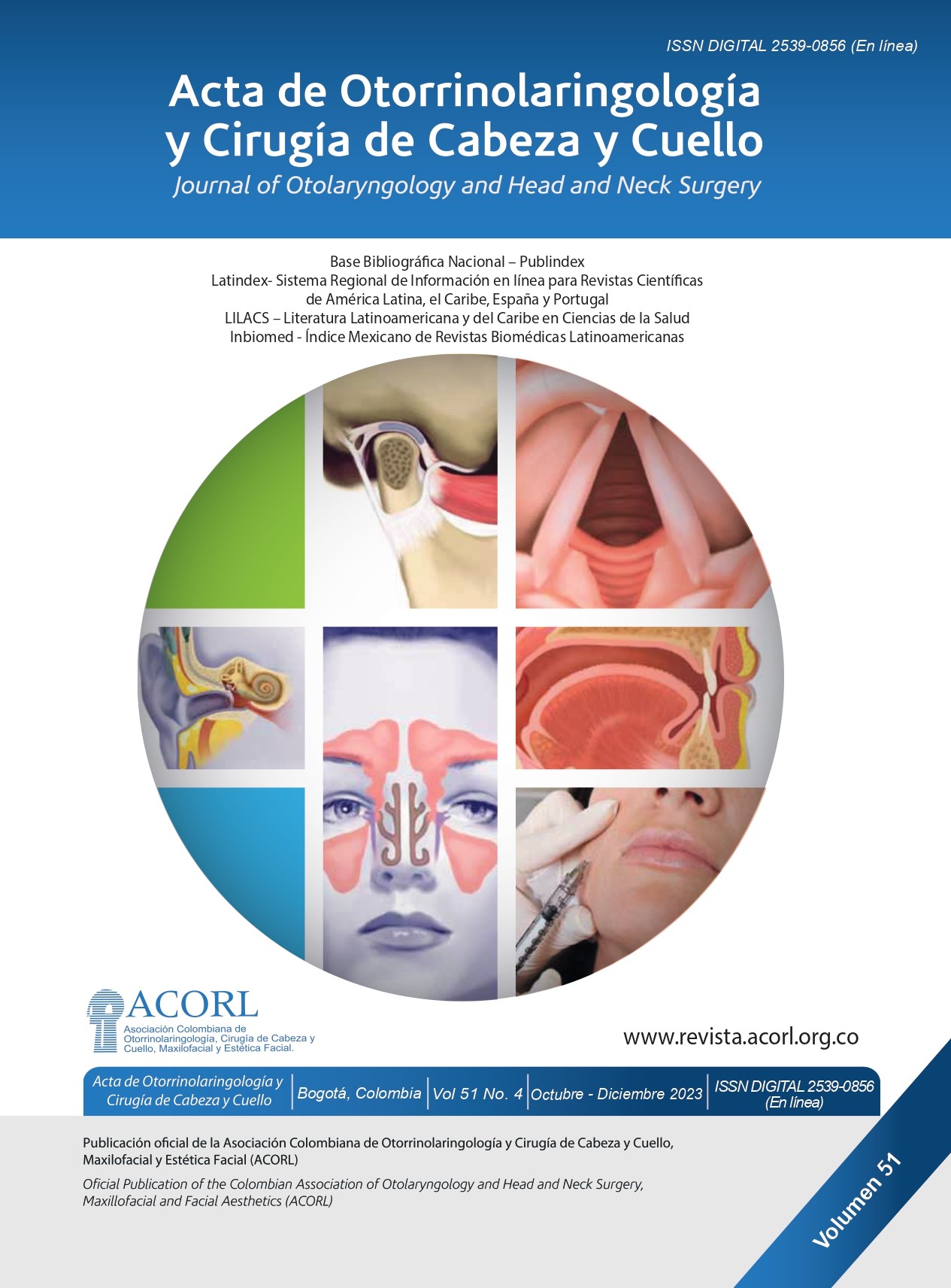Factores predictores de desenlaces auditivos en pacientes llevados a reconstrucción de la cadena osicular en un país en vía de desarrollo.
Contenido principal del artículo
Resumen
Objetivo: Evaluar los factores sociales y clínicos que predicen los desenlaces audiométricos en pacientes llevados a reconstrucción de cadena osicular en un país envía de desarrollo. Métodos: Se realizo un estudio de cohorte analítico retrospectivo donde se incluyeron pacientes mayores de 18 años, con antecedente de otitis media crónica y/o alguna complicación/secuela de esta, que fueron llevados a reconstrucción de la cadena osicular con prótesis PORP - TORP de la Fundación Universitaria de Ciencias de la Salud entre el año 2012 y 2020, se excluyeron pacientes con malformaciones de la cadena osicular y aquellos con información incompleta de su historia clínica y quirúrgica. Resultados: La población estudiada fue 35 pacientes, en los cuales se compararon variables demográficas, antecedentes de rinitis o tabaquismo activo, parámetros audiológicos pre y postoperatorios, y hallazgos intraquirurgicos. Se evidenció una diferencia estadísticamente significativa entre el promedio tonal auditivo (PTA) preoperatorio y el PTA postoperatorio (p-valor=0.036), así como en el gap aéreo- óseo pre y post operatorio ( p-valor < 0.01). Se reportó un coeficiente de correlación moderado entre el índice OOPS y el PTA post operatorio (p = 0.429), y entre el índice OOPS y el gap aéreo óseo post operatorio (p = 0.653), lo que indica que a mayor puntaje en el índice OOPS peores desenlaces auditivos. Conclusión: En este estudio un mayor puntaje en el índice OOPS se correlacionó con peores desenlaces auditivos.
Detalles del artículo
Sección

Esta obra está bajo una licencia internacional Creative Commons Atribución-CompartirIgual 4.0.
Este artículo es publicado por la Revista Acta de Otorrinolaringología & Cirugía de Cabeza y Cuello.
Este es un artículo de acceso abierto, distribuido bajo los términos de la LicenciaCreativeCommons Atribución-CompartirIgual 4.0 Internacional.( http://creativecommons.org/licenses/by-sa/4.0/), que permite el uso no comercial, distribución y reproducción en cualquier medio, siempre que la obra original sea debidamente citada.
eISSN: 2539-0856
ISSN: 0120-8411
Cómo citar
Referencias
Otoya-Tono AM, Pérez-Herrera LC, Peñaranda D, Moreno López S, Sánchez-Pedraza R, García JM, et al. Validation of a Spanish version of the health-related quality of life (HRQoL) measure for Chronic Otitis Media (COMQ-12). Health and Quality of Life Outcomes. 2020 Dec 1;18(1):362. doi: 10.1186/ s12955-020-01616-5.
Pérez-Herrera LC, Peñaranda D, Moreno-López S, Otoya-Tono AM, Gutiérrez-Velasco L, García JM, et al. Associated factors, health-related quality of life, and reported costs of chronic otitis media in adults at two otologic referral centers in a middle income country. PLoS One. 2020 ;15(12):e0244797. doi: 10.1371/journal.pone.0244797. eCollection 2020..
Bakhshaee M, Rajati M, Fereidouni M, Khadivi E, Varasteh A. Allergic rhinitis and chronic suppurative otitis media. Eur Arch Otorhinolaryngol 2011;268(1):87-– 91. doi: 10.1007/s00405- 010-1290-3
Alles R, Parikh A, Hawk L, Darby Y, Navas Romero J, Scadding G. The prevalence of atopic disorders in children with chronic otitis media with effusion Pediatr Allergy Immunol. 2001;12(2):102-–6. doi: 10.1046/j.0905-6157.2000.00008.x. Colombia.
Ministerio de Salud y Protección Social. Registro Individual de Prestación de Servicios de Salud de Otitis Media Crónica [Individual register of Healthcare services— Chronic Otitis Media.]. Available from: https://www.sispro.gov.co/central gestion-delconocimiento/Pages/construya-su-consulta afiliaciones-en-salud.aspx.
Cox MD, Page JC, Trinidade A, Dornhoffer JL. Long-term complications and surgical failures after ossiculoplasty. Otol Neurotol. 2017. ;38(10):1450-5. doi: 10.1097/MAO.0000000000001572.
Dornhoffer JL, Friedman AB, Gluth MB. Management of acquired cholesteatoma in the pediatric population. Curr Opin Otolaryngol Head and Neck Surg. 2013;21(5): doi: 10.1097/ MOO.0b013e32836464bd.
Javia LR, Ruckenstein MJ. Ossiculoplasty. Otolaryngol Clin North Am. 2006;39(6): 1177–89. doi: 10.1016/j. otc.2006.08.010.
Dornhoffer JL, Gardner E. Prognostic Factors in Ossiculoplasty: A Statistical Staging System. 2001. Otol Neurotol. 2001;22(3):299- 304.. doi: 10.1097/00129492-200105000- 00005.
Kotzias SA, Seerig MM, Mello MFPC de, Chueiri L, Jacques J, Silva MBC da, et al. Ossicular chain reconstruction in chronic otitis media: Hearing results and analysis of prognostic factors. Braz J Otorhinolaryngol. 2020;86(1):49–55. doi: 10.1016/j. bjorl.2018.09.005.
de Vos C, Gersdorff M, Gérard JM. Prognostic Factors in Ossiculoplasty. Otol Neurotol. 2007;28(1)61-7. doi: 10.1097/01. mao.0000231598.33585.8f.
Gluth MB, Moore PC, Dornhoffer JL. Method and Reproducibility of a Standardized Ossiculoplasty Technique. Otol Neurotol. 2012;33(7):1207-12. doi: 10.1097/ MAO.0b013e31825f2387.
Phillips JS, Haggard Y,Yung M. A New Health-Related Quality of Life Measure for Active Chronic Otitis Media (COMQ12): Development and Initial Validation Otol Neurotol. 2014;35(3):454-8. doi: 10.1097/MAO.0000000000000205.
Caloway CL, Basonbul RA, Ronner EA, Tolisano AM, Zhu AW, Suresh H, et al. Pediatric Endoscopic Ossiculoplasty Following Surgery for Chronic Ear Disease. Laryngoscope. 2020;130(12):2896–9. doi: 10.1002/lary.28526.
Das A, Mitra S, Ghosh D, Sengupta A. Endoscopic ossiculoplasty: Is there any edge over the microscopic technique? Laryngoscope. 2020;130(3):797–802. doi: 10.1002/lary.28074.





